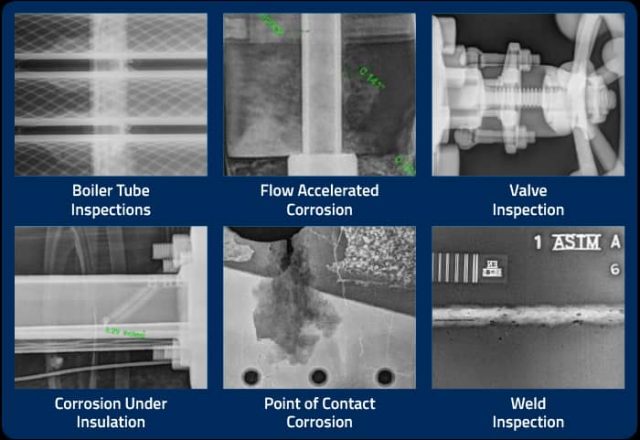ADVANCE NDT
- DIGITAL RADIOGRAPHY TESTING (DRT)
- PHASED ARRAY ULTRASONIC TESTING (PAUT)
- CORROSION MAPPING
- LONG RANGE ULTRASONIC TESTING (LRUT)
Digital Radiography Testing (DRT)
 Unlike conventional radiography, digital radiography does not require film. Instead, it uses a digital detector (Panel) to display radiographic images on a computer screen almost instantaneously. It allows for a much shorter exposure time so that the images can be interpreted more quickly
Unlike conventional radiography, digital radiography does not require film. Instead, it uses a digital detector (Panel) to display radiographic images on a computer screen almost instantaneously. It allows for a much shorter exposure time so that the images can be interpreted more quickly
Furthermore, the digital images produced by this method are of higher quality when compared to conventional radiographic images. With the ability to capture quality images, this technology can be utilized to identify flaws in a material, foreign objects in a system, examine weld repairs and inspect a material for corrosion under insulation.
The four most commonly utilized digital radiography techniques in the oil & gas and chemical processing industries are Computed Radiography, Digital Radiography, Real-time Radiography and Computed Tomography
Phased Array Ultrasonic Testing (PAUT)

Phased Array Ultrasonic Testing (PAUT) is an advanced nondestructive examination technique that utilizes a set of ultrasonic testing (UT) probes made up of numerous small elements, each of which is pulsed individually with computer-calculated timing. This technique can be used to inspect more complex geometries that are difficult and much slower to inspect with single probes.
PAUT can be used to inspect almost any FR material where a traditional UT method have been utilized, and is often used for weld inspections and crack detection.
Compared to conventional UT, PAUT has several advantages. PAUT can be conducted more quickly than other forms of UT, often within a fraction of a second. It can easily be used for repeat scans because it has a high degree of repeatability.
Corrosion Mapping

A successful corrosion mapping inspection is the result of the combination of a high probability of detection on corrosion damages like pitting, with the confidence that the full area of interest has been totally covered. In recent years, the situation has changed with the availability of off-the-shelf phased array equipment.
These solutions offer an improvement of the ratio lateral resolution versus surface scanned speed as well as the availability of two axis scanners
Long Range Ultrasonic Testing (LRUT)

Long Range Ultrasonic Testing (LRUT) sometimes referred to as Guide Wave Ultrasonic Testing (GWUT) is an advanced nondestructive examination technique that was developed for testing large volumes of material from a single test point. What differentiates this from more traditional methods of ultrasonic testing is that, with LRUT, a liquid couplant between transducers and the surface is not required. For this reason LRUT is one of the fastest inspection tools for carrying out pipeline surveys for corrosion and other damage mechanisms.
LRUT is performed using a system which is made up of a low frequency flaw detector, a pulsar receiver unit, some transducer rings, and a laptop computer which contains the software that controls the system. To begin, the transducer rings are fixed around a pipe, through which they will then generate a series of low frequency guided waves. It’s the uniform spacing of the ultrasonic transducers around the circumference of the pipe allows for the guided waves to propagate symmetrically along the pipe axis, providing complete, 100% coverage of the pipe wall, including areas such as at clamps and sleeved or buried pipes. The waves are then reflected back to the transducer whenever they reach a change in wall thickness, which is how the process is able to detect corrosion, metal loss, or discontinuities.
LRUT is an invaluable nondestructive testing technique that has applications throughout the oil and gas industry. It is widely used in the inspection of pipes in areas such as road and river crossings, power plant tubing, risers, offshore topside pipework, jetty lines, and refinery pipework for the detection of issues such as corrosion under insulation. It has also found widespread use in situations where pipes or tubes are not accessible to other detection methods such as for pipes buried in soil, those encased in a sleeve, or those positioned at a high elevation.
